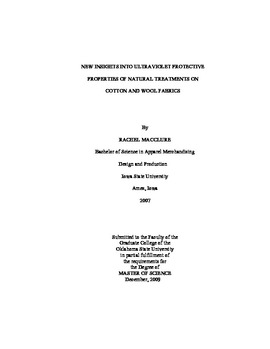| dc.contributor.advisor | Farr, Cheryl A. | |
| dc.contributor.author | MacClure, Rachel Jean | |
| dc.date.accessioned | 2014-04-15T18:40:56Z | |
| dc.date.available | 2014-04-15T18:40:56Z | |
| dc.date.issued | 2009-12-01 | |
| dc.identifier.uri | https://hdl.handle.net/11244/8601 | |
| dc.description.abstract | The purpose of this experimental study was to explore alternative treatments to create an organic form of UV protection, e.g. natural benzophenone treatments that can be applied to clothing. The proposed research focused on the relationship among three North American dye plants (Rhubarb, Great St. John's Wort, and Kalm St. John's Wort) that contain benzophenone, a mordant (Glauber's Salt) and two natural fibers (Cotton and Wool) to form an ultraviolet protection barrier for human skin. Specific objectives of this study were to identify the UV protection imparted by: a) Cotton and wool in shirt weight fabrics, b) Fabrics treated with and without mordant of Glauber's salt, and c) Fabrics treated with each of the benzophenone treatments (Rhubarb, Great St. John's Wort and Kalm St. John's Wort). Cotton and Wool fabric samples were treated with Glauber's salt and each of the benzophenone treatments. Control fabric samples were used for comparison with each of the treated samples. Spectrophotometer readings were taken to gather ultraviolet transmittance, following the AATCC test method 183: Transmittance or Blocking of Erythemally Weighted Ultraviolet Radiation through Fabrics. Comparing each of these benzophenone treatments, it can be speculated that rhubarb root provides the greatest level of UVA and overall UV protection when treated upon cotton and wool fabrics. Kalm St. John's Wort root provided the highest level of protection within the UVB wavelength range, but when averaged with it's UVA protection ability, Kalm St. John's Wort averaged one percentage lower than rhubarb. Wool fabric treated with each of the benzophenone treatments provided a greater level of protection of those cotton samples receiving treatment, but this is due to the higher level of UV protection initially provided by untreated wool. Comparing the difference in UV protection change, cotton fabrics treated with the experimental benzophenone treatments had a UV protection change of 4.3%, while wool fabrics receiving the same treatments exhibited a UV protection change of 3.3%. Therefore, it can be determined, referring to this experimental study, that cotton fabrics exhibited a higher level of ultraviolet protection (across the 280-400 wavelength range) when treated with the stated benzophenone treatments. | |
| dc.format | application/pdf | |
| dc.language | en_US | |
| dc.publisher | Oklahoma State University | |
| dc.rights | Copyright is held by the author who has granted the Oklahoma State University Library the non-exclusive right to share this material in its institutional repository. Contact Digital Library Services at lib-dls@okstate.edu or 405-744-9161 for the permission policy on the use, reproduction or distribution of this material. | |
| dc.title | New Insights into Ultraviolet Protective Properties of Natural Treatments on Cotton and Wool Fabrics | |
| dc.type | text | |
| dc.contributor.committeeMember | Swinney, Jane | |
| dc.contributor.committeeMember | Blackwell, Cindy Southard | |
| osu.filename | MacClure_okstate_0664M_10686.pdf | |
| osu.college | Human Environmental Sciences | |
| osu.accesstype | Open Access | |
| dc.description.department | Department of Design, Housing and Merchandising | |
| dc.type.genre | Thesis | |
| dc.subject.keywords | aatcc 183 | |
| dc.subject.keywords | benzophenone | |
| dc.subject.keywords | fabric | |
| dc.subject.keywords | organic | |
| dc.subject.keywords | skin cancer | |
| dc.subject.keywords | ultraviolet radiation | |
